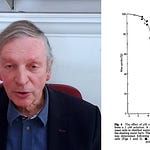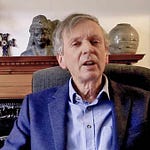In this interview, I explore a new theory with physicist Sky Darmos that challenges our fundamental understanding of gravity.
My own interest in the subject began with a puzzling scientific anomaly: measurements of the gravitational constant (Big G) vary significantly across experiments—especially when different materials are used—far beyond what standard error margins can explain. While conventional physics dismisses these variations as experimental errors, Darmos offers an alternative explanation.
Darmos’ hypothesis is that gravity depends not on mass (as Newton and Einstein proposed) but on the total count of protons and neutrons (baryons). He explains how nuclear binding energy creates a discrepancy between an element's actual mass and what we might expect from its particle count. According to his theory, elements with high binding energy like iron exert stronger gravitational forces per unit mass because they contain more particles relative to their measured mass.
Darmos supports his hypothesis with several lines of evidence:
Analysis of G Measurements: A graph compiling decades of Cavendish-type experiments shows a strong correlation between the measured value of G and the specific materials used for the source and test masses, aligning with his predictions based on particle count and binding energy. The statistical significance is extremely high.
Free-Fall Experiments: He cites experiments (like Szasz's Bremen Drop Tower test and independent pendulum experiments) suggesting different materials fall at slightly different rates in a vacuum, contrary to the equivalence principle but consistent with his theory. Neutron free-fall experiments also show neutrons falling slower than expected based on mass equivalence alone.
Proposed Mechanism: Darmos describes gravity ("chromo-gravity") as an emergent effect arising from the strong nuclear force. Baryons emit virtual gluons, which modify the structure of a quantized, "granular" space (composed of overlapping spheres or bubbles). Denser regions of particles create denser space with more pathways, causing attraction. Electro-gravity from electrons is considered negligible or very short-range.
Astrophysical Implications: His theory reportedly provides better explanations for the perihelion precession of Mercury and Saturn, resolves the observed mass gap between neutron stars and black holes (by assigning them higher effective G values due to extreme density and binding energy), and explains subtle variations in Kepler's planetary ratios based on planetary composition.
Cosmology: He briefly touches on his alternative cosmology involving an infinite universe expanding due to an "entropic principle" (compensating for entropy increase in black holes), starting slowly ("Big Tardiness") rather than a hot Big Bang, and potentially eliminating the need for dark matter/energy as currently conceived.
Of course, it is difficult for Darmos to get his ideas discussed within the established scientific system, facing inertia and a lack of access to certain data or expensive equipment (like precise gravimeters). I appreciate his independence of thought, empirical focus, and persistence against the mainstream. But I don’t know how right or wrong he is – I hope we will all find out through further experimental research.
Video Timestamps:
00:00:00 Introduction & Setup
00:04:07 Rupert Sheldrake: The Problem of Varying Gravitational Constants (Big G)
00:07:04 Challenges Discussing Varying Constants with Physicists
00:10:13 Why Sky Darmos's Work is Different (Empirical Focus)
00:12:07 Sky Darmos's Theory: Gravity Depends on Particle Count (Protons/Neutrons), Not Mass
00:12:54 The Role of Nuclear Binding Energy (Negative Mass Contribution)
00:13:35 Iron Has the Highest Gravity Per Unit Mass
00:15:03 Graph: G Measurements Correlate with Material Composition
00:16:13 How Gravity is Measured: The Cavendish Balance Experiment
00:21:58 Conventional Views vs. Darmos's Material-Dependent Explanation
00:24:18 The Recent Standardization Using Stainless Steel
00:26:35 Free-Fall Experiments: Do Different Materials Fall Differently?
00:27:48 Szasz's Bremen Drop Tower Experiment (Challenging Equivalence)
00:30:28 Video of Szasz's Free-Fall Experiment
00:36:47 Neutron Free-Fall Experiments Show Slower Fall Rate
00:40:56 Why is the Theory Controversial? (Particle Count vs. Mass/Energy)
00:41:12 Darmos's Mechanism: Quantized "Granular" Space & Virtual Particles
00:43:27 Chromo-Gravity (Strong Force) vs. Electro-Gravity (Weak/Short Range)
00:46:05 Speed of Gravity Discussion (vs. Van Flandern)
00:49:10 How Gluons and Particle Count Relate to Gravity
00:52:50 Calculating G for Different Elements (Hydrogen, Iron, Lead)
00:58:57 Calculating G for Molecules (Water) and Mixed Materials (Geometric Mean)
01:00:00 More on the Concept of Granular Space
01:04:09 Implications for Cosmology: Entropic Expansion & "Big Tardiness"
01:09:40 Dark Energy Not Needed in this Model
01:10:00 Further Evidence: Independent Pendulum Experiments Confirm Material Dependence
01:13:03 Weighing Experiments and the Need for Gravimeters
01:14:56 Potential for Gravity Manipulation (Inflated Mass)
01:16:01 Neutron Stars & Black Holes Have Higher G Values
01:17:07 Solving the Neutron Star / Black Hole Mass Gap Problem
01:19:51 Explaining Perihelion Precession (Mercury, Saturn) Better Than GR
01:23:10 Double Pulsar Orbit Decay Fits Theory
01:24:02 Revisiting the Eötvös Experiment (5th Force Idea)
01:26:27 Kepler's Planetary Ratios Show Composition Dependence
01:29:39 Challenges Getting the Theory Accepted / Being Outside the System
01:32:05 Where to Find Sky Darmos's Work (Book, ResearchGate)
01:33:04 Influence of Roger Penrose
01:34:20 The Simplicity of the Theory Compared to GR Complexity
01:36:05 Closing Remarks & Future Topics (Consciousness, Morphic Resonance)











